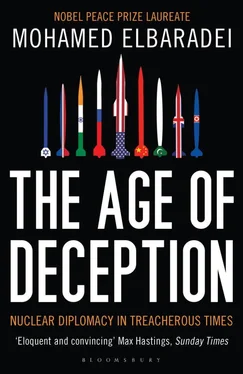This package, unlike the first one in August 2005, was quite generous. It specifically offered to provide Iran with Western conventional and nuclear power technology. It discussed elements of a trade agreement with the West. And it was written without the patronizing tone of the first offer, referring respectfully to Iran’s rights. However, it repeated the demand that Iran suspend its enrichment program as a prerequisite of negotiations, and the language seemed to predicate Iran’s resumption of enrichment activities on the West’s approval.
Iran said they wanted until August 22 to respond. Meanwhile, they continued to expand their enrichment R&D; by this point, they had moved from experimenting with 10- and 20-centrifuge cascades to a 164-centrifuge cascade, still a pilot-scale operation. The activity was not very sustained. They would run a cascade for ten days, stop for a few days, then start again. Our technical experts believed the Iranians could have been proceeding much faster had they wanted to make an all-out effort. At one point, the Iranians mentioned that they might have a second 164-machine cascade in place in another three months. I advised them against it. Building more and larger cascades would only make the negotiations that much harder.
Iran’s request for more time was viewed with suspicion by some in the West. The Americans and others asserted that Iran would use the time to build up its enrichment capacity. This was absurd. Iran would hardly be any further along in its R&D program in August than it was in June. I believed the request for time was a function of the slow pace of Iranian decision making. Iran’s domestic political processes are full of checks and balances; multiple parties weigh in with their reflections before the formulation of a final strategy. The Iranians never seem to be in a rush, and they are even more resistant to hasty decision making when put under external pressure.
But the United States did not want to wait and insisted that Solana push for a meeting with the P-5 well before Iran’s requested response date. Larijani agreed to meet in Brussels, on July 11, because he wanted to clarify details on the terms and scope of the proposed suspension. It was clear from our conversations that he was committed to finding a negotiated solution.
As it turned out, the meeting did more harm than good. In the middle of the conversation, John Sawers, the British director general for political affairs at the Foreign and Commonwealth Office, grew impatient. He forcefully interrupted Solana to demand of Larijani, “We want to know in concrete terms whether you are ready to suspend.”
Of course, Larijani was not able to give an affirmative answer. Tehran had not yet agreed on its response. Larijani equivocated, and the conversation ended awkwardly. Solana reported that the meeting had failed and the very next day, the so-called P-5+1 [4] The P-5 (permanent members of the Security Council) plus Germany, who were working more or less as a unit in the negotiations at the time.
announced their intention again to refer the matter to the Security Council.
Soon after, at the G-8 Summit in St. Petersburg, I had a brief talk with President Bush. “ElBaradei!” he called out, coming toward me with a smile. “We really appreciate your work in Iran,” he said quietly, after shaking my hand, “because we don’t know what’s going on there.”
Iran was working on an answer to the offer, I told him. I believed they sincerely wanted to find a solution through negotiation and that they simply needed a bit more time.
“We are ready” was Bush’s response, signaling that he wanted to hear what Tehran had to say.
In a separate conversation, Tony Blair gave me exactly the same answer—“We are ready”—as if the two men had rehearsed it.
As the Security Council began edging its way toward a resolution, Javad Vaeedi, Larijani’s deputy, came to see me. The gist of the conversation was that the Iranians were prepared to agree to suspension, but not as a precondition of the negotiations, only as an outcome. Suspension would also need to be linked to some type of security assurance. “We want to know whether our counterpart is an ally or an adversary,” Vaeedi told me. “The issue is not just the nuclear program. It is the entire future relationship between America and Iran.”
He explained the situation facing Ahmadinejad domestically. “If he only announces the suspension of nuclear enrichment, without something about security in return, the Ahmadinejad administration will collapse.” What Vaeedi said next was both illuminating and disturbing. The previous negotiating team—the group headed by Rowhani, who had served under the Khatami administration—was now opposing any move to suspend enrichment and accept the package. The problem was not the offer itself, which was obviously much better than the previous year’s package. Their concern was that acceptance of the offer and negotiations with the United States toward normalizing relations would make Ahmadinejad a national hero. That was the last thing they wanted, so they were busily undermining the very solution they had worked so hard to achieve.
I sighed. Tehran had been spending way too much time watching D.C. politics, I thought.
Another opportunity was on the verge of being squandered. I called Greg Schulte, the U.S. ambassador to the IAEA, and asked him to relay to Washington that the window of opportunity was still open. The possibility of a broad-based regional security solution was still on the table. The missing ingredient was only the willingness of the United States to make a small, and meaningless, concession to get the dialogue under way.
But it was not to be. At the end of July 2006, three weeks before Iran had promised to provide its answer, the Security Council adopted Resolution 1696. The resolution made enrichment suspension mandatory under Chapter VII of the UN Charter, which empowers the Security Council to act in the face of “threats to the peace, breaches of the peace, and acts of aggression.” By the end of August, I was required to report to the council confirming that Iran had suspended its uranium enrichment operations.
It was hard for me to imagine a less sensible, more divisive action than Resolution 1696. First, the investigation of Iran’s nuclear program had, at that point, been ongoing for nearly four years. Waiting three weeks for Iran’s answer, using those weeks to find a solution to the suspension question—this would have been an eminently reasonable investment of time and energy. I began to feel that the policy makers in Washington were perhaps not really interested in resolving the Iranian nuclear issue and talking to Tehran. Could it be that the U.S. leadership was hostage to those who wanted only confrontation, isolation, and regime change?
Second, the resolution was of dubious legality. There was still no proof that Iran’s nuclear activity involved a weapons program. It was quite a stretch to say that a small laboratory-scale centrifuge cascade constituted “a threat to international peace and security” when peaceful uranium enrichment is legal for all states under the NPT.
Third, the resolution lacked logic. If there was genuine concern that Iran was developing a nuclear weapon, stopping its small-scale enrichment operation in exchange for dialogue and normalization made no sense at all. What difference would it make to halt this declared R&D operation if Iran actually had an operative nuclear weapons program? The real focus should have been on continuing IAEA inspections in Iran to investigate any possible undeclared enrichment or clandestine weaponization activities. Putting all the focus on the enrichment R&D at Natanz made clear that the concern—the supposed “threat to international peace and security”—was less about an ongoing secret weapons program than about having apparently reached a verdict on Iran’s future intentions.
Читать дальше












